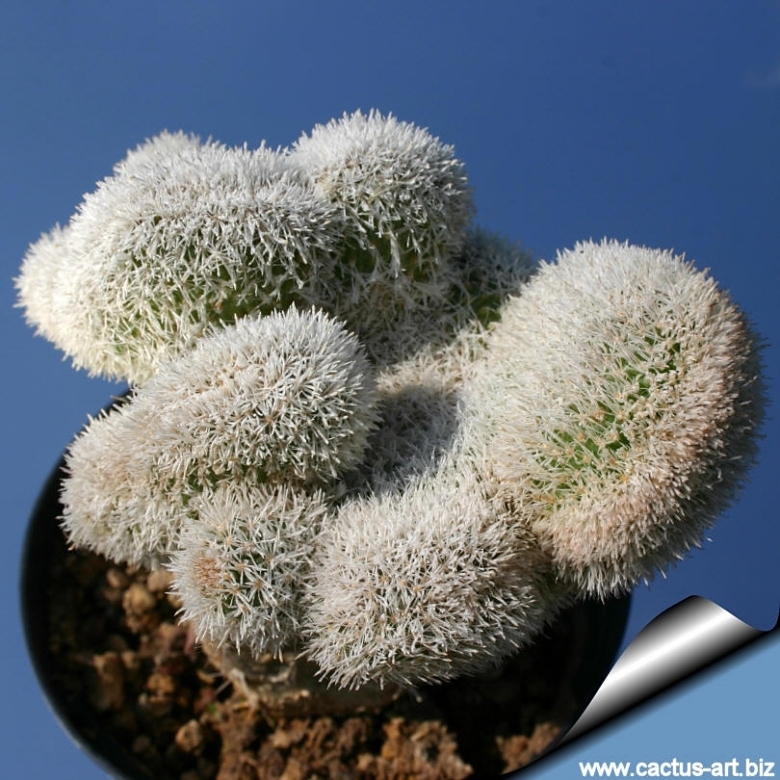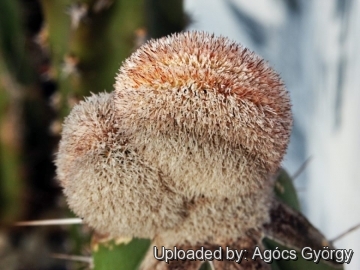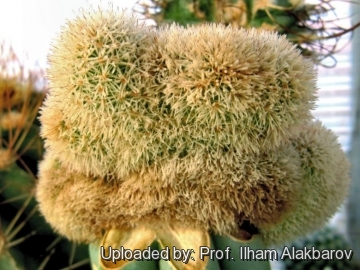= Haageocereus lanugispinus f. cristatus hort.
Accepted Scientific Name: Haageocereus tenuis F.Ritter
Kakteen Südamerika 4: 1421 (fig.). 1981

Pygmaeocereus densiaculeatus f. cristatus (Haageocereus lanugispinus f. cristatus) Photo by: Cactus Art
It is a beautiful crested plant often found in collections with its older name Pygmaeocereus densiaculeatus.
Origin and Habitat: Garden origin (Nursery produced cultivar).
Synonyms:
See all synonyms of Haageocereus tenuis
back
Accepted name in llifle Database:Haageocereus tenuis F.RitterKakteen Südamerika 4: 1421 (fig.). 1981Synonymy: 8
back
Description: Haageocereus lanugispinusSN|3862]]SN|3862]] is a very rare and poorly known small finger sized cactus. It seems that there is only ONE clone propagated in collections worldwide! The crested form Haageocereus lanugispinusSN|3862]]SN|3862]] f. cristatus is very rare and sought after by collectors, for its unique dense cover of glassy white spines.
Root: Has a large tap root below the surface of the compost.
Stem: Fan shaped, narrow, slowly forming tangled brain-like stems up to 15 (or more) cm across, almost completely hidden under a dense cover of glassy white spines.
Spines: Most unusual dense, plumose, short, glassy white, which detach very easily.
Flower: White.
Remarks: This plant seems to be very rarely seen in its "normal" form, as it is almost always seen the cristate form. However the crested form sometimes throws off normal stems, but they proved to be particularly difficult to root, for this reason the few plants found in specialized cactus collections are - usually - grafted.
More...Subspecies, varieties, forms and cultivars of plants belonging to the Haageocereus tenuis group
 Haageocereus lanugispinus F.Ritter: has cylindrical stems 10-20 cm long, 1.2 2 cm in diameter. Spines 30-40 dense, 3-5 mm long, unequal, needle-like, glassy white. Distribution: North of Pativilca, Peru.
Haageocereus lanugispinus F.Ritter: has cylindrical stems 10-20 cm long, 1.2 2 cm in diameter. Spines 30-40 dense, 3-5 mm long, unequal, needle-like, glassy white. Distribution: North of Pativilca, Peru. Haageocereus lanugispinus f. cristatus hort.: Crested form. It has its unique dense cover of glassy white spines.
Haageocereus lanugispinus f. cristatus hort.: Crested form. It has its unique dense cover of glassy white spines. Haageocereus tenuis F.Ritter: has rooting slender, prostrate stems 1.5-3 cm in diameter. Central spines 7-10 to 20 mm long. Radial spines 30, 2-3 mm long. Distribution: Between Chancay and Huacho, north of Lima, Peru.
Haageocereus tenuis F.Ritter: has rooting slender, prostrate stems 1.5-3 cm in diameter. Central spines 7-10 to 20 mm long. Radial spines 30, 2-3 mm long. Distribution: Between Chancay and Huacho, north of Lima, Peru.
Bibliography: Major references and further lectures
1) Edward Anderson “The Cactus family” Timber Press, Incorporated, 2001
2) David R Hunt; Nigel P Taylor; Graham Charles; International Cactaceae Systematics Group. "The New Cactus Lexicon" dh books, 2006
3) Tropicos.org. Missouri Botanical Garden. 12 Aug 2015 <http://www.tropicos.org/Name/5101809>
4) M. Arakaki, C. Ostolaza, F. Cáceres & J. Roque. “Cactaceae endémicas del Perú (Cactaceae endemic of Peru)” Revista Peruana de Biología v.13 n.2 Lima Dec. 2006
5) C. Ostolaza. “Todos los cactus del Perú” pag. 298. Lima, Ministerio del Ambiente, Dec. 2014. http://www.minam.gob.pe/diversidadbiologica/wp-content/uploads/sites/21/2014/02/document.pdf
6) Håkan Sönnermo “Peru: land of deserts, ice, cacti” Acta Succulenta 2(3) [257-362] 2014-10-20 <http://acta-succulenta.eu/dwn/en/ActaSucculenta_2_3_2014_EN.pdf>
More... Pygmaeocereus densiaculeatus f. cristatus (Haageocereus lanugispinus f. cristatus) Photo by: Agócs György
Pygmaeocereus densiaculeatus f. cristatus (Haageocereus lanugispinus f. cristatus) Photo by: Agócs György Pygmaeocereus densiaculeatus f. cristatus (Haageocereus lanugispinus f. cristatus) Photo by: Prof. Ilham Alakbarov
Pygmaeocereus densiaculeatus f. cristatus (Haageocereus lanugispinus f. cristatus) Photo by: Prof. Ilham AlakbarovCultivation and Propagation: It is regarded as a choice and difficult plant and grows quite slowly. It is almost always seen as a grafted plant but may grows on its own roots too.
Soil: Use mineral well permeable mineral soil with little organic matter (peat, humus).
Exposure: They need a good amount of light shade to full sun this help to keep the plants healthy, although slow growth.
Watering: Water sparingly from March till October (weekly during summertime, if the weather is sunny enough), with a little fertilizer added. Less or no water during cold winter months, or when night temperatures remain below 10° to prevent root loss. It is very sensitive to overwatering (rot prone).
Fertilization: Feeding may not be necessary at all if the compost is fresh then, feed in summer only if the plant hasn't been repotted recently. Do not feed the plants from September onwards as this can cause lush growth which can be fatal during the darker cold months.
Hardiness: Keep perfectly dry in winter at temperatures from 5 to 15 degrees centigrade. (but it is relatively cold resistant and hardy to -5° C, or possibly colder for short periods) In the rest period no high atmospheric humidity!! (Temperature Zone: USDA 9-11)
Crested growth: Unlike 'monstrose' varieties of plants, where the variation from normal growth is due to genetic mutation, crested growth can occur on normal plants. Sometimes it's due to variances in light intensity, or damage, but generally the causes are unknown. A crested plant may have some areas growing normally, and a cresting plant that looks like a brain, may revert to normal growth for no apparent reason. If you have any of the crested part left you need to remove the normal growth and leave the crested part behind this will need to be done regularly.
Propagation: Grafting or cuttings. Plants are usually grafted onto column-shaped cacti but proved to be able to produce their own roots if degrafted. Cuttings will take root in a minimum temperature of 20° C (but better in hot weather). Cuttings of healthy shoots can be taken in the spring and summer. Cut the stem with a sharp, sterile knife, leave the cutting in a warm, dry place for a week or weeks (depending on how thick the cutting is) until a callus forms over the wound. Once the callus forms, the cutting may be inserted in a container filled with firmed cactus potting mix topped with a surface layer of coarse grit. They should be placed in the coarse grit only; this prevents the cut end from becoming too wet and allows the roots to penetrate the rich compost underneath. The cuttings should root in 2 to 6 weeks. Large crested piece must be placed on the soil surface without burying the plant base down in the soil.
More...












